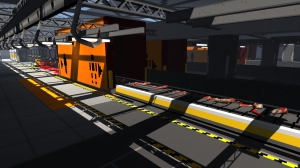
Image source: nomand and Lundum Dare
Alexey Botkov, a game creator who is part of the Frogshark game studio in Auckland, New Zealand, recently participated in a Ludum Dare competition (a “game jam”) in which game designers, working alone, had only 48 hours to create a video game. The theme: “You are the monster.”
Many competitors took a literal view of the theme, creating games wherein the player controls a traditional, Godzilla-like monster. Botkov took a different tack: “I wanted the theme to carry a self-reflective quality for the player instead of a literal representation in the game.”
In That Cow Game (downloadable for free for Windows and OSX here), the player plays a pixelated cow, who wanders among the whirring, clanking machines of an equally pixelated slaughterhouse. The difference here is that the cow is the factory foreman, and the infinite line of processed carcasses are all human.
Created in just 48 hours, the game is, by necessity, minimalist: the graphics are simple and blocky, and there isn’t any actual goal. This arguably makes the game experience even more haunting and thought-provoking. A reviewer from Popular Science noted, “As the cow (the main character), you’re really only tasked with walking back and forth along the assembly line for as long as it takes you to realize there’s nothing you can do to affect the process. Whether that moment was intentional or not, it left an unsettling feeling hanging in the air. I kept wondering: Was there something I can do? Am I missing something to stop this?”

Image source: nomand
The player’s only source of interaction with unfolding events is an ability to headbutt the human corpses as they roll by. The carcasses are the only “squishy” looking items in the game, created with a deliberate, visually unique feel to separate them from the rest of the space. They feel out of place in the huge, industrial factory. “If I was to add anything it would be sound and a variety of voices coming from the humans as you bump into them,” Botkov says.
The game has only minimal, pixelated gore, and it won’t necessarily turn you vegan — Botkov himself is an omnivore — but it invites thought about the nature of our food production processes.
“I eat meat and I am a monster, really,” he says. “More so because I’m aware of the issues, yet I’m still complicit. I guess [with the game] I’m questioning my own relationship with the whole thing and trying to figure out what my values are.”





